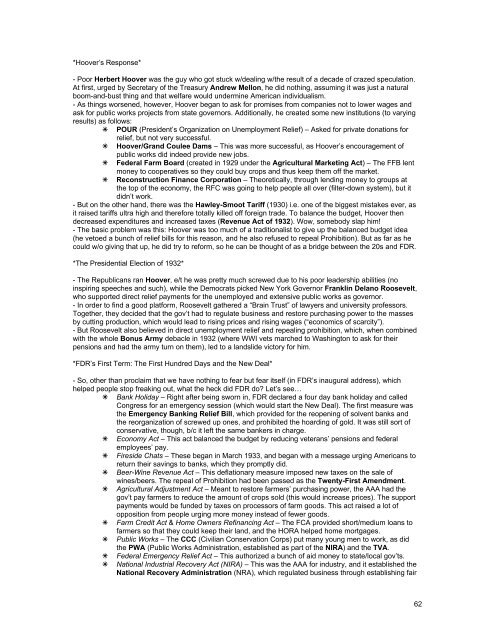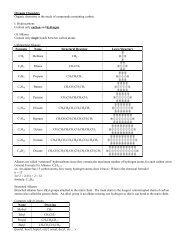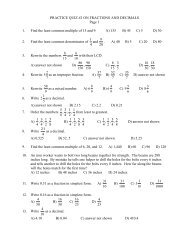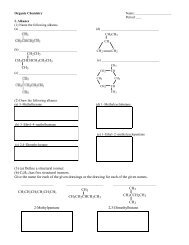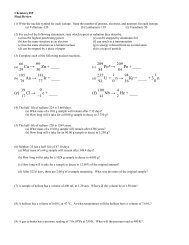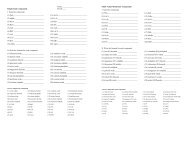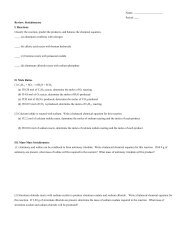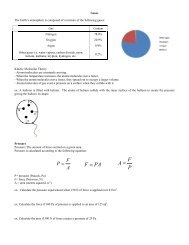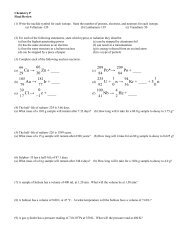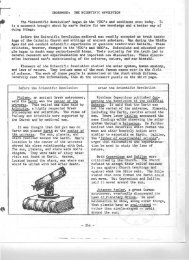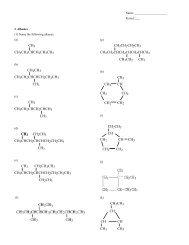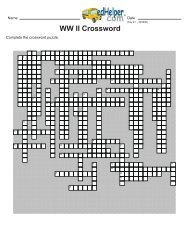*Hoover’s Response*- Poor Herbert Hoover was the guy who got stuck w/dealing w/the result of a decade of crazed speculation.At first, urged by Secretary of the Treasury Andrew Mellon, he did nothing, assuming it was just a naturalboom-and-bust thing and that welfare would undermine <strong>Am</strong>erican individualism.- As things worsened, however, Hoover began to ask for promises from <strong>com</strong>panies not to lower wages andask for public works projects from state governors. Additionally, he created some new institutions (to varyingresults) as follows: POUR (President’s Organization on Unemployment Relief) – Asked for private donations forrelief, but not very successful. Hoover/Grand Coulee Dams – This was more successful, as Hoover’s encouragement ofpublic works did indeed provide new jobs. Federal Farm Board (created in 1929 under the Agricultural Marketing Act) – The FFB lentmoney to cooperatives so they could buy crops and thus keep them off the market.Reconstruction Finance Corporation – Theoretically, through lending money to groups atthe top of the economy, the RFC was going to help people all over (filter-down system), but itdidn’t work.- But on the other hand, there was the Hawley-Smoot Tariff (1930) i.e. one of the biggest mistakes ever, asit raised tariffs ultra high and therefore totally killed off foreign trade. To balance the budget, Hoover thendecreased expenditures and increased taxes (Revenue Act of 1932). Wow, somebody slap him!- The basic problem was this: Hoover was too much of a traditionalist to give up the balanced budget idea(he vetoed a bunch of relief bills for this reason, and he also refused to repeal Prohibition). But as far as hecould w/o giving that up, he did try to reform, so he can be thought of as a bridge between the 20s and FDR.*The Presidential Election of 1932*- The Republicans ran Hoover, e/t he was pretty much screwed due to his poor leadership abilities (noinspiring speeches and such), while the Democrats picked New York Governor Franklin Delano Roosevelt,who supported direct relief payments for the unemployed and extensive public works as governor.- In order to find a good platform, Roosevelt gathered a “Brain Trust” of lawyers and university professors.Together, they decided that the gov’t had to regulate business and restore purchasing power to the massesby cutting production, which would lead to rising prices and rising wages (“economics of scarcity”).- But Roosevelt also believed in direct unemployment relief and repealing prohibition, which, when <strong>com</strong>binedwith the whole Bonus Army debacle in 1932 (where WWI vets marched to Washington to ask for theirpensions and had the army turn on them), led to a landslide victory for him.*FDR’s First Term: The First Hundred Days and the New Deal*- So, other than proclaim that we have nothing to fear but fear itself (in FDR’s inaugural address), whichhelped people stop freaking out, what the heck did FDR do? Let’s see… Bank Holiday – Right after being sworn in, FDR declared a four day bank holiday and calledCongress for an emergency session (which would start the New Deal). The first measure wasthe Emergency Banking Relief Bill, which provided for the reopening of solvent banks andthe reorganization of screwed up ones, and prohibited the hoarding of gold. It was still sort ofconservative, though, b/c it left the same bankers in charge. Economy Act – This act balanced the budget by reducing veterans’ pensions and federalemployees’ pay. Fireside Chats – These began in March 1933, and began with a message urging <strong>Am</strong>ericans toreturn their savings to banks, which they promptly did. Beer-Wine Revenue Act – This deflationary measure imposed new taxes on the sale ofwines/beers. The repeal of Prohibition had been passed as the Twenty-First <strong>Am</strong>endment. Agricultural Adjustment Act – Meant to restore farmers’ purchasing power, the AAA had thegov’t pay farmers to reduce the amount of crops sold (this would increase prices). The supportpayments would be funded by taxes on processors of farm goods. This act raised a lot ofopposition from people urging more money instead of fewer goods. Farm Credit Act & <strong>Home</strong> Owners Refinancing Act – The FCA provided short/medium loans tofarmers so that they could keep their land, and the HORA helped home mortgages. Public Works – The CCC (Civilian Conservation Corps) put many young men to work, as didthe PWA (Public Works Administration, established as part of the NIRA) and the TVA. Federal Emergency Relief Act – This authorized a bunch of aid money to state/local gov’ts. National Industrial Recovery Act (NIRA) – This was the AAA for industry, and it established theNational Recovery Administration (NRA), which regulated business through establishing fair62
production codes, limiting production and pricing, and guaranteeing the right of workers tounionize and bargain collectively. Federal Securities Act & Banking Act of 1933 – The FSA enforced rules among brokers, andthe Banking Act set up the Federal Deposit Insurance Corporation (FDIC) to insure bankdeposits. The US was also taken off the gold standard, so the Federal Reserve Board couldexpand the currency in circulation.- Believe it or not, all those bills were passed in the Hundred Days, and they saved the nation from hysteriaand panic. Other bills passed after in FDR’s first term include: the Commodity Credit Corporation (lentfarmers money for keeping underpriced crops off the market), the Securities and Exchange Commissionand the Taylor Act (established federal supervision of public lands).*Opposition to the New Deal*- Although the Democrats won big time in the Congressional elections in 1934 and the New Deal had mademajor progress, the problem was far from solved, and once there was partial recovery, people startedwhining about FDR’s policies.- Many conservatives, for instance, said there was too much regulation, taxation, and government spending.The <strong>Am</strong>erican Liberty League (conservative Democrats and corporation leaders) led this with calls that theNew Deal was destroying the <strong>Am</strong>erican individualistic tradition.- On the flip side, some farmers/laborers and such felt the NRA set prices too high (favored big business)and that the AAA was no good b/c it led to waste when people were starving and didn’t encourage landlordsto keep their tenant farmers, as was hoped.- Then there were a series of demagogic attacks – i.e. people who went around conveniently blamingeverything on some big power elites. Examples of these people include: Father Charles Coughlin: A Roman Catholic priest who specialized in anti-<strong>com</strong>munism, anticapitalism,and anti-Semitism – “conspiracy of Jewish bankers.” Francis Townsend: Old Age Revolving Pensions Plan, where the gov’t would give old people$ on the condition they spend it fast (to pump $ into the economy).Huey Long: “Every Man a King, but No One Wears a Crown.” At first a ND supporter, Longswitched to the idea of the Share Our Wealth Society in 1934, which was basically a 100%tax rate on in<strong>com</strong>es over a million. Long was on the way up politically, but was assassinated.- Of course, there were also socialists and the new Communist Party of the US, which had changed itsstrategy to supporting a “Popular Front” instead of trying to overthrow the gov’t.- The biggest threat to the ND, though, was actually the Supreme Court, which felt the new legislation gavethe President too much power. So in Schechter v. US (1935) they got rid of the NIRA (federal gov’t has noright to regulate intrastate business), and in US v. Butler the AAA was invalidated for the same reason.*The Second New Deal and Roosevelt’s Second Term*- As the election of 1936 approached, FDR was worried that his ND coalition was breaking up, so hedecided to take the initiative again in 1935 and pass a bunch of new laws now referred to as the SecondNew Deal. The SND differed from the first b/c it bashed business more instead of cooperating w/it.- Programs in the Second New Deal included: Emergency Relief Appropriation Act – Let the President establish big public works programsfor the unemployed, like the Resettlement Administration, Rural ElectrificationAdministration, and the Nat’l Youth Administration. Works Progress/Projects Administration (WPA) – Funded by the ERAA, the WPA was a majorpublic works organization and also sponsored cultural programs that brought art to the peopleby employing artists, ex. Federal Writers Program, which was accused by some as being leftwingpropaganda (since most involved were decidedly to the left). National Labor Relations (Wagner) Act – This act established the National Labor RelationsBoard, which was empowered to guarantee democratic union elections and stop unfair laborpractices, like the firing of union members. Social Security Act – This act established old-age insurance in which workers paid taxes out oftheir wages, which were then matched by their employers and stored for use as benefitsstarting at age 65. The act also included other federal/state welfare programs.Public Utility Holding Company (Wheeler-Rayburn) Act & Wealth Tax Act – The tax act raisedin<strong>com</strong>e taxes on rich people.- Then the Presidential Election of 1936 rolled around, and FDR totally creamed the Republican nominee,and the Democrats gained in the Congress too. FDR’s supporters are known as the New Deal Coalition,and they consisted of urban (immigrant) workers, organized labor, the “Solid South,” and northern blacks.63
- Page 3 and 4:
Congregationalists (Puritans) - The
- Page 5 and 6:
- So the Restoration Colonies, form
- Page 7 and 8:
- So in England, where they were lo
- Page 9 and 10:
*Colonial Politics 1700-1750: Relat
- Page 11 and 12: - Another ideology that was beginni
- Page 13 and 14: - The Quebec Acts were passed aroun
- Page 15 and 16: - So, by 1782, what had seemed to b
- Page 17 and 18: on the economic side, since the gov
- Page 19 and 20: - Anyway, Congress had several ques
- Page 21 and 22: - Adams was still in the early Wash
- Page 23 and 24: *Political Factionalism and Jeffers
- Page 25 and 26: - Samuel Slater set up the first te
- Page 27 and 28: - Court rulings extended the powers
- Page 29 and 30: Revival, Reform and Politics during
- Page 31 and 32: - Anyhow, during his administration
- Page 33 and 34: TEXAS (Southerners) - Texas had bee
- Page 35 and 36: - Anyhow, Pierce’s total support
- Page 37 and 38: They had a smaller everything: smal
- Page 39 and 40: - The two Northern victories at the
- Page 41 and 42: - The result was the Fourteenth Ame
- Page 43 and 44: The Slaughter-House Cases (1873) -
- Page 45 and 46: in the arrest of 8 immigrant radica
- Page 47 and 48: case (1897 - ICC can’t set rates)
- Page 49 and 50: - The Populists prepared to run aga
- Page 51 and 52: - MOST IMPORTANTLY, though, was the
- Page 53 and 54: - So, what led the US to undertake
- Page 55 and 56: - The rebellion, led by Emilio Agui
- Page 57 and 58: - Still, Americans managed to turn
- Page 59 and 60: - So - the point of this episode? B
- Page 64 and 65: - In FDR’s second term, however,
- Page 66 and 67: Dominican Republic - When we left i
- Page 68 and 69: World War II (1941 - 1945)*The Cour
- Page 70 and 71: - So Truman started off again all c
- Page 72 and 73: - First of all, the 1950s were (for
- Page 74 and 75: peace w/Japan that ended occupation
- Page 76: - France wanted out, so at the Gene


